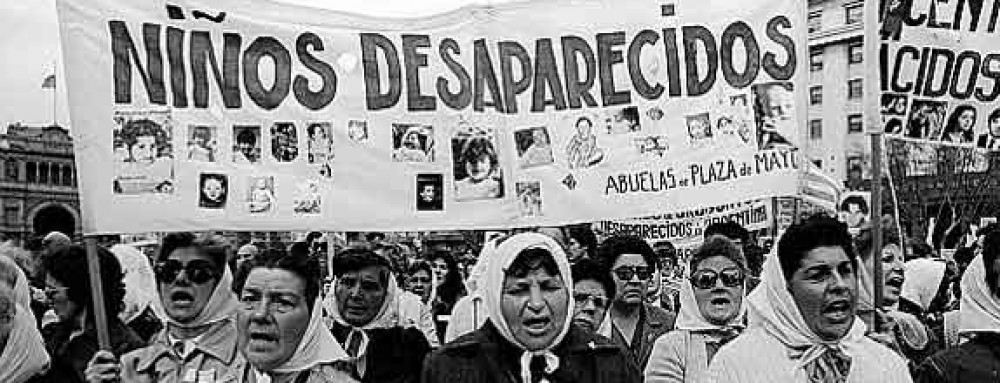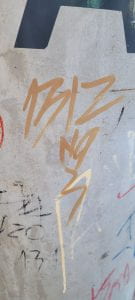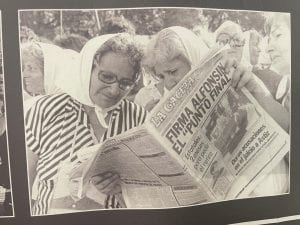One of the last Memory Sites we visited was Club Atletico. What made it so different from the other sites we had visited was its location as an outdoor excavation underneath a highway overpass. This shows the precariousness of some of these sites, as it could easily have been destroyed in the construction. Although it was not specifically mentioned, Club Atletico clearly relates to Mercedes Doretti and Jennifer Burrell’s article on Forensic Anthropology and Human Rights. Their observations discuss the difficulty of reconstructing these sites and the intersectional disciplines needed for the process. It made me think of how I perceived the site as an archeological site, but digging up the recent past rather than an ancient civilization. It also touched on how excavating a site like this is so important for evidence in ongoing trials, to ensure that those imprisoned there receive the justice they deserve.
Category Archives: 2. How are Argentinians still dealing with the effects of the “Dirty War?”
Symbolism in Argentine Art
 We spoke a lot about how certain images have become symbolic in the Argentine consciousness. What do these paintings symbolize for you?
We spoke a lot about how certain images have become symbolic in the Argentine consciousness. What do these paintings symbolize for you?

These paintings are by the artist Maria La Serna and were a part of her exhibition Terrenos de la expresión (Grounds of expression) at the contemporary art museum in Cordoba. They are meant to show impressions of daily life and are not related to the Desaparecidos. The dress is not meant to show an absence, the white scarf belongs to a butcher rather than a Madre de Plaza de Mayo, and the small portraits are of her friends and family. I wanted to call attention to the fact that while it is important to understand the cultural symbolism in Argentine art, we also must be careful not to bring in preconceptions and to understand the context.
Political Graffiti?
These pictures came from the pillars of the Women’s Memorial that many have posted about. I was conflicted when I saw that many people had written things that were vulgar and unrelated to the memorial. I wondered if people understood the Memorial or just thought of it as another place to tag. I could understand the 1312 tag (the numbers corresponding to ACAB-All Cops Are Bastards. The police complicity in the wrongful kidnappings and murders seemed to warrant a statement of solidarity expressed by these tags. Lesbianizate seemed less appropriate, but could possibly be seen to show a feminist statement.
Memory, not Erasure
I was surprised to find that ESMA was so close to residential buildings and businesses in the city. I had expected it to be more out of the way, like La Perla. Several of these buildings were there at the time of the dictatorship, so the residents may have even been aware of ESMA being used as a detention center. So many more of these sites were in places where people lived or traveled past than I expected. It was also interesting to learn that under Menem’s presidency, ESMA was supposed to be torn down and developed, becoming just another part of the surrounding neighborhood, all evidence of atrocities committed simply erased. I’m glad activists were able to fight to prevent that and instead to turn it into a memory site, and that their voices were heard. I feel like the site would have likely been built over if it was in the U.S., sadly, as there is a tendency to gloss over any negative history. It is also a contrast to Club Atlético. While also a memory site, it had a highway built over it, in an attempt by the dictatorship to erase the history, whether intentional or not, and seems to not be getting many resources to uncover more of the buried space.
Argentinian Life
 Life in Argentina seems to be pretty normal. The people that lived through the *Dirty War” are desperate to keep the memory alive so that it never happens again. The younger generation is more interested in their phones and other electronics. The ones who are supposed to be teaching the younger generations may do it or may not. We can only control ourselves so I think it is basically up to the parents to try to instill the horror of these human rights violations on their children. I also thank and praise those who are running and working at the memory sites for doing their part in the attempt for “Nunca Mas”.
Life in Argentina seems to be pretty normal. The people that lived through the *Dirty War” are desperate to keep the memory alive so that it never happens again. The younger generation is more interested in their phones and other electronics. The ones who are supposed to be teaching the younger generations may do it or may not. We can only control ourselves so I think it is basically up to the parents to try to instill the horror of these human rights violations on their children. I also thank and praise those who are running and working at the memory sites for doing their part in the attempt for “Nunca Mas”.
Women’s March
The murdered women had not belonged to a militaristic organization or even a political one; they were barely a dozen unarmed people whose only link was their kinship to others who had disappeared. From the flight confessions of an Argentine Dirty Warrior.
We will be marching with the Mothers of
Plaza de Mayo. This is a way many women show their strength from their last trauma. I noticed a photo of women that wore the white head scarfs. These women are standing up so they wouldn’t be silenced or feel as if their lives have little meaning. The women looked exhausted and were reading about the Punto Final. Which seemed to be a big issue around the 1980’s. This is a very important movement to many people. So I am very excited to be a part of something that is near and dear to many people’s hearts.
Madres y Abuelas de Plaza de Mayo
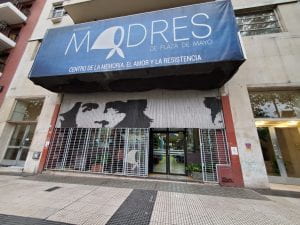 In “Children of the Dirty War: Argentinas stolen orphans” F. Goldman tells how Maria Isabel Chorobik de Mariani went to some meetings of the Madres de Plaza de Mayo and then started the Abuelas de Plaza de Mayo to join with other grandmothers who were looking for their missing grandchildren. Maria thinks she has found her grandchild but it took years to get the children to consent to be tested. So, after believing or at least hoping for many years, she is disappointed to find that she is not related. False hope can be very devastating. I was very happy to learn about the database where people born during the years of those disappeared and those who lost a grandchild can register with their dna. Hopefully many, many more will be found.
In “Children of the Dirty War: Argentinas stolen orphans” F. Goldman tells how Maria Isabel Chorobik de Mariani went to some meetings of the Madres de Plaza de Mayo and then started the Abuelas de Plaza de Mayo to join with other grandmothers who were looking for their missing grandchildren. Maria thinks she has found her grandchild but it took years to get the children to consent to be tested. So, after believing or at least hoping for many years, she is disappointed to find that she is not related. False hope can be very devastating. I was very happy to learn about the database where people born during the years of those disappeared and those who lost a grandchild can register with their dna. Hopefully many, many more will be found.
The Exhaustion of Reconciling With Trauma and Justice
One of the more moving days was our visits to D2 and La Perla, where we got an insight into the experiences of those who were kidnapped or disappeared.
The featured photo for this post depicts a young woman and her presumed daughter analyzing a map of where Argentine people fled during the dictatorship. The woman was naming different places that had lights on them. D2 isn’t particularly large, and I found myself running into these two multiple times. When we made it to the more open area in front of the only two cells D2 has, I saw that there was another woman with the two. They went into one of the cells, and when they came out, I saw tears. Both the women were crying, and they embraced each other before moving on to another room. I have never seen anyone cry like that at a memorial in the United States. I wondered if they had a relative or friend that was disappeared, or if the general devastation of D2 brought them to tears.
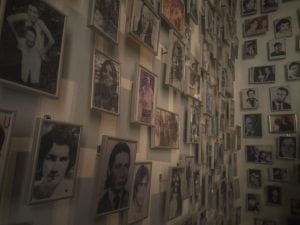
Either way, I got a first-hand look at the impact of the “Dirty War” on the Argentine people. There are families still searching for answers about what happened to their loved ones and seeking justice. The trials that began in 2010, while necessary for bringing a sliver of justice to the disappeared, have forced victims to relive their experiences and potentially testify in front of their abuser. Adopted children of the disappeared either have no idea or have to grapple with the trauma of not only being adopted but having parents that were murdered with no chance of raising them. While it is heartening to know that people are actively seeking justice in larger movements, it is hard to imagine the exhaustion of such an endeavor. The author of Nunca Mas notes that some families never even reported their disappeared loved ones for fear of “a resurgence of these evil forces.”
Memory All Around Us
Walking through the city with a few others as we returned from the artist market, we caught sight of this graffiti featuring “Nunca Mas” and the instantly recognizable headscarf of the Madres of the Plaza de Mayo. We had nearly missed it among the other graffiti covering the walls. I found I have learned a lot about the political climate in Còrdoba and the larger country from looking at the messages left as graffiti around the city, plus it has helped me with reading in Spanish. Seeing this and several similar works while out last night made it clear that the terrors of the dictatorship are still on people’s minds, and it has been woven into the fabric of the city. Graffiti is a valuable way of seeing what is on people’s minds in any given place, and is a good art form for processing experiences and advocating for change. It is seen as disruptive when in many cases, that is the point. It is a creative way for anyone to make themselves heard. In “Sources and Expression of Resilience in Trauma Survivors,” Harvey and Tummala-Narra state that resilience and self-healing, while important, is only part of the story for survivors. They are also fighting for justice and change, so what happened to them will not happen again. The phrase Nunca Mas (“never again”), popularized by the 1984 report, and the fight of the Madres encapsulate the importance of not just resilience but justice perfectly.
La Perla .. The Pearl or is it ?
 I got a chance to visit La Perla detention center. How weird for a name of a place where many went missing, were tortured and/or “transferred” to their final resting place? As I walked through each building I could feel the energy throughout the rooms. The main offices were closed due to investigations still taking place. There is a possibility that blood stains from the walls of these rooms could provide more evidence for these crimes against humanity. It was interesting to learn that victims didn’t need much other than a full description of the place for their testimony to stand in court. We learned about a lady who counted each step she took while being blindfolded in the barrack, and that alone helped prove that she had been placed in this horrendous place.
I got a chance to visit La Perla detention center. How weird for a name of a place where many went missing, were tortured and/or “transferred” to their final resting place? As I walked through each building I could feel the energy throughout the rooms. The main offices were closed due to investigations still taking place. There is a possibility that blood stains from the walls of these rooms could provide more evidence for these crimes against humanity. It was interesting to learn that victims didn’t need much other than a full description of the place for their testimony to stand in court. We learned about a lady who counted each step she took while being blindfolded in the barrack, and that alone helped prove that she had been placed in this horrendous place.
.  The countryside beside the torture room is where many people were taken to be shot in the head. Mass graves should be present but nothing not even the bones of one person was found. This has me thinking that the military must’ve known that they were being investigated and went to extremes to get rid of their evidence of genocide. As stated in ‘Argentina’s Missing Bones’, despite suspicion of a mass grave near the La Perla detention center, the EAAF has failed to locate such remains. Rumors are that military workers dug all the bones up and crushed them into a powder so that none of the remains could be traced. I was shocked to hear that people would go to these lengths to cover up their wrongdoings. The families are still dealing with the hurt of not knowing where the remains of their missing loved ones are. There is a lot of evidence still being held from the community that could better assist these families in their healing journey. NO JUSTICE, MEANS NO PEACE!
The countryside beside the torture room is where many people were taken to be shot in the head. Mass graves should be present but nothing not even the bones of one person was found. This has me thinking that the military must’ve known that they were being investigated and went to extremes to get rid of their evidence of genocide. As stated in ‘Argentina’s Missing Bones’, despite suspicion of a mass grave near the La Perla detention center, the EAAF has failed to locate such remains. Rumors are that military workers dug all the bones up and crushed them into a powder so that none of the remains could be traced. I was shocked to hear that people would go to these lengths to cover up their wrongdoings. The families are still dealing with the hurt of not knowing where the remains of their missing loved ones are. There is a lot of evidence still being held from the community that could better assist these families in their healing journey. NO JUSTICE, MEANS NO PEACE!
